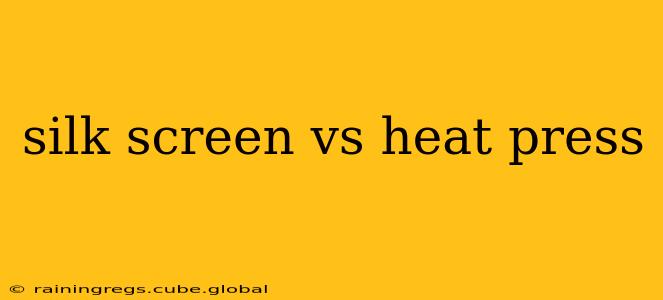Choosing the right printing method for your project can be a daunting task, especially when faced with options like silk screen printing and heat transfer printing. Both offer unique advantages and disadvantages, making the "best" choice entirely dependent on your specific needs and budget. This comprehensive guide will delve into the key differences between silk screen printing and heat transfer printing, helping you make an informed decision.
What is Silk Screen Printing?
Silk screen printing, also known as screen printing, is a stencil printing technique where ink is pressed through a mesh screen onto a substrate (like t-shirts, mugs, or posters). A stencil, blocking the ink from passing through in certain areas, creates the design. This method is ideal for producing high-quality prints with vibrant colors and a durable, long-lasting finish.
Advantages of Silk Screen Printing:
- Durability: Silk screen prints are incredibly durable and can withstand repeated washing and wear.
- Vibrant Colors: This method allows for rich, saturated colors, offering excellent color accuracy and detail.
- Large-Scale Production: Screen printing is exceptionally efficient for mass production, making it cost-effective for large orders.
- Variety of Substrates: It can be used on a wide array of materials, including fabrics, paper, wood, and metal.
Disadvantages of Silk Screen Printing:
- Setup Costs: Creating the screens and setting up the process can be expensive, making it less ideal for small print runs.
- Time-Consuming: The process is relatively time-consuming, especially for intricate designs or multiple colors.
- Less Detail for Complex Designs: While capable of detail, achieving extremely fine details can be challenging and may require multiple screens.
What is Heat Transfer Printing?
Heat transfer printing uses a heat press to transfer an image from a special paper onto a substrate. The image is printed onto the transfer paper using inkjet or laser printers, then applied using heat and pressure. This process is significantly faster and cheaper for smaller runs than screen printing.
Advantages of Heat Transfer Printing:
- Low Setup Costs: There's minimal upfront investment, making it perfect for small businesses or one-off projects.
- Fast Turnaround: The printing and transfer process is quick, resulting in faster production times.
- Detailed Images: Heat transfer printing excels at reproducing intricate designs and fine details with great accuracy.
- Variety of Materials: While best on certain fabrics, it's applicable to various substrates, including mugs, phone cases, and even some fabrics.
Disadvantages of Heat Transfer Printing:
- Less Durable: Heat transfer prints are generally less durable than screen prints and may fade or crack with repeated washing or wear, especially on fabrics.
- Limited Color Range: While detail is high, the color vibrancy might not match the richness achieved through screen printing.
- Higher Cost per Unit (Small Orders): While setup costs are low, the per-unit cost can be higher than screen printing for large orders.
- Image Quality Dependent on Transfer Paper: The quality of the final product depends heavily on the quality of the transfer paper and the printing process.
Silk Screen Printing vs. Heat Transfer Printing: A Side-by-Side Comparison
| Feature | Silk Screen Printing | Heat Transfer Printing |
|---|---|---|
| Cost per Unit | Lower for large orders | Lower for small orders |
| Setup Costs | Higher | Lower |
| Durability | High | Low to Moderate |
| Color Vibrancy | High | Moderate |
| Detail | Moderate | High |
| Production Speed | Slower | Faster |
| Best For | Large orders, durable prints | Small orders, detailed prints |
Which Method is Right for You?
The best printing method hinges on your specific project requirements. Consider the following:
- Order Quantity: For large orders, screen printing is usually more economical. Small orders are better suited for heat transfer.
- Budget: Heat transfer has lower upfront costs, while screen printing's cost is spread over more units.
- Desired Durability: If long-lasting prints are essential, silk screen printing is the superior choice.
- Design Complexity: Intricate designs often benefit from the detail capabilities of heat transfer printing.
- Substrate Type: Both methods work on a variety of materials, but some substrates are better suited for one method over the other.
By carefully weighing these factors, you can determine whether silk screen printing or heat transfer printing is the best fit for your next project. Remember, consulting with a printing professional can provide further insights and ensure you achieve the optimal results.
